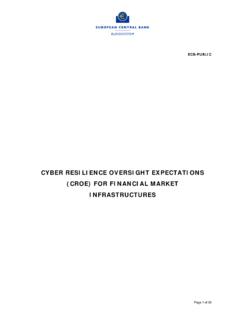Transcription of The Impacts of Large Research Infrastructures on …
1 The Impacts of Large Research Infrastructures on economic innovation and on Society: Case Studies at CERN The Organisation for economic Co-operation and Development (OECD) is a unique forum where governments work together to address the economic , social and environmental challenges of globalisation. The OECD is also at the forefront of efforts to understand and to help governments respond to new developments and concerns, such as corporate governance, the information economy and the challenges of an ageing population. The Organisation provides a setting where governments can compare policy experiences, seek answers to common problems, identify good practice and work to co-ordinate domestic and international policies. The OECD member countries are: Australia, Austria, Belgium, Canada, Chile, the Czech Republic, Denmark, Estonia, Finland, France, Germany, Greece, Hungary, Iceland, Ireland, Israel, Italy, Japan, Korea, Luxembourg, Mexico, the Netherlands, New Zealand, Norway, Poland, Portugal, the Slovak Republic, Slovenia, Spain, Sweden, Switzerland, Turkey, the United Kingdom and the United States.
2 The European Union takes part in the work of the OECD. The Global Science Forum (GSF) is a venue for consultations among senior science policy officials of the OECD member and partner countries on matters relating to scientific Research . The Forum s activities produce findings and recommendations for actions by governments, international organisations, and the scientific community. The Forum serves its member delegations by exploring opportunities for new or enhanced international co-operation in selected scientific areas; by defining international frameworks for national or regional science policy decisions; and by addressing the scientific dimensions of issues of social concern. The Forum s reports are available at The GSF staff are based at OECD headquarters in Paris, and can be contacted at OECD 2014 Cover photo CERN Requests for permission to reproduce or translate all or part of this work should be addressed to: 3 THE Impacts OF Large Research Infrastructures ON economic innovation AND ON SOCIETY: CASE STUDIES AT CERN OECD 2014 FOREWORD Since the creation of the OECD Megascience Forum in 1992, which was renamed the Global Science Forum (GSF) in 1999 after the broadening of its mandate, Research Infrastructures have been a major topic for analysis and discussion at the Organisation for economic Co-operation and Development.
3 Following a publication on Large Research Infrastructures , which dealt with the challenges associated with launching and managing Large single-site facilities, this new report addresses the potential economic and societal Impacts of international Research facilities, using case studies from one of the largest global Research Infrastructures : the European Organisation for Nuclear Research (CERN). The GSF undertook this study following an initial approach by CERN, which was interested in having an external perspective that could serve as a basis for further optimising the organisation s policies and procedures as well as being of value to CERN s member states. The GSF approach, although based on the analysis of CERN s achievements and policies, aimed to shed light on generic issues that could be applicable more broadly to international Research Infrastructures .
4 This report is based on case studies that were carried out using two sources of information: papers/articles and interviews, which were carried out by Dr Stefan Michalowski from the GSF Secretariat with nearly fifty key individuals. These included staff at CERN, experts from outside of CERN and current or former employees of companies that manufactured some of CERN s major equipment. The GSF s objective was not to carry out an exhaustive analysis but rather to derive useful lessons and practices for administrators, funding agencies and policymakers, who are faced with challenging decisions about implementing new infrastructure projects and programmes (or about upgrading or terminating existing ones). We hope that this report will be informative and useful and we would be interested in receiving comments from readers. The GSF staff can be reached at The OECD Committee for Scientific and Technological Policy approved this report in June 2014.
5 5 THE Impacts OF Large Research Infrastructures ON economic innovation AND ON SOCIETY: CASE STUDIES AT CERN OECD 2014 TABLE OF CONTENTS FOREWORD .. 3 EXECUTIVE SUMMARY .. 7 Section A. Rationale, background and objectives .. 10 Section B. Methodology .. 12 Section C. Impact categories .. 13 Category I. Purely scientific results, intended to advance fundamental knowledge .. 14 Category II. The direct and indirect Impacts of spending for building and operating the laboratory .. 15 Category III. Training for scientists, engineers, technicians, administrators and other professionals . 18 Category IV. Achieving national, regional and global goals; strengthening international scientific co-operation .. 19 Categories V and VI. These categories are treated in detail in Section D.. 20 Section D. Case studies of selected CERN 20 Section Case study: LHC main ring dipole magnets .. 20 Section Rationale for this case study.
6 20 Section Background and incentives for technological innovation .. 21 Section Dipole magnet Research and development .. 29 Section Procurement, manufacturing and testing .. 32 Section Conclusions concerning the dipole magnets .. 34 CERN as a generator of technological challenges and solutions .. 34 Risk management and governance .. 35 The role of external entities .. 37 Section Case study: hadron cancer therapy .. 38 Section Introduction to hadron therapy .. 38 Section History of CERN s involvement in hadron 41 Section Recent developments and prospects for the future .. 50 Section Conclusions concerning hadron therapy .. 52 CERN as an enabler of innovation .. 52 Governance and operations .. 54 CERN as a pan-European institution .. 55 Section Case study: software packages .. 56 Section Education and outreach (impact Category VI) .. 58 Section E. Knowledge transfer .. 60 Section F. General observations.
7 62 Status of CERN as a European organisation .. 62 Operations and governance .. 64 REFERENCES .. 66 APPENDIX A. MEMBERS OF THE INTERNATIONAL EXPERTS GROUP, APPOINTED BY GSF DELEGATIONS .. 68 APPENDIX B. LIST OF INTERVIEWED EXPERTS .. 69 APPENDIX C. INTRODUCTION TO THE SCIENTIFIC RATIONALE OF THE LHC PROJECT .. 70 APPENDIX D. OPERATIONAL HADRON THERAPY FACILITIES AROUND THE WORLD .. 74 APPENDIX E. HADRON THERAPY FACILITIES AROUND THE WORLD: UNDER CONSTRUCTION OR PLANNED .. 76 APPENDIX F. ABOUT THE OECD GLOBAL SCIENCE FORUM .. 78 7 THE Impacts OF Large Research Infrastructures ON economic innovation AND ON SOCIETY: CASE STUDIES AT CERN OECD 2014 EXECUTIVE SUMMARY This report of the OECD Global Science Forum (GSF) is an examination of some of the economic and societal Impacts of a well-known international Research facility: the European Organisation for Nuclear Research (CERN). Via a few case studies, this report aims to shed light on generic questions that could be applicable to any number of potential future international Research Infrastructures .
8 Among the beneficiaries of the study will be government officials who seek to understand all of the ways in which the outcomes of publicly-funded Research can benefit national economies and can affect the lives of citizens in general. Similarly, facility administrators are always interested in optimising their organisational structures, procedures and internal policies to better manage useful secondary outcomes, and to maximise social/ economic Impacts without detracting from primary Research objectives. Scientific leaders who are exploring the prospects of future new facilities will benefit from the results of this OECD study as well, by being able to anticipate relevant opportunities and challenges, and perhaps incorporating the findings of the study into future governance structures as they are being designed. In this study, four impact categories were analysed, related to (i) innovations needed for major CERN component development; (ii) innovations unrelated to the facility needs; (iii) software applications; (iv) education and public outreach.
9 I. The ability of CERN to carry out internally major technological innovation efforts associated with the design, development and fabrication of essential components of its Research infrastructure, such as the dipole magnets of the Large Hadron Collider, was linked to a number of practical features: Its size, which allows CERN to accommodate the various early stages of a project without detracting from its on-going authorised and funded projects. Its internal staff, who have advanced knowledge of the various design and engineering possibilities of equipment, have access to extensive international networks, and have the capacity to develop long-range plans besides their primary work assignment. Its degree of flexibility in the management and internal accounting procedures. The decision to develop internally such technological effort is largely associated with risk management strategies and constraints.
10 In the case of Large equipment possessing unique technological characteristics, a number of challenges have to be met: Respond to time, schedule and cost constraints for unique and highly innovative equipment. Avoid potential legal proceedings with under-performing contractors. Avoid risks related to juste retour mechanisms. Internal development of these challenging new technological components requires a number of features: 8 THE Impacts OF Large Research Infrastructures ON economic innovation AND ON SOCIETY: CASE STUDIES AT CERN OECD 2014 The capacity to set up strong control and oversight of its partners. Because CERN s budget is provided by cash contributions from its Member States, it is free to specify the degree of control it wishes in its call for tenders, which may not be the case for projects based on in-kind contributions. The capacity to call for external expertise and contribution from affiliated and associated Research institutions when in-house knowledge and experience is insufficient (CERN is one of the central nodes of the Research community and organisations in physics).















